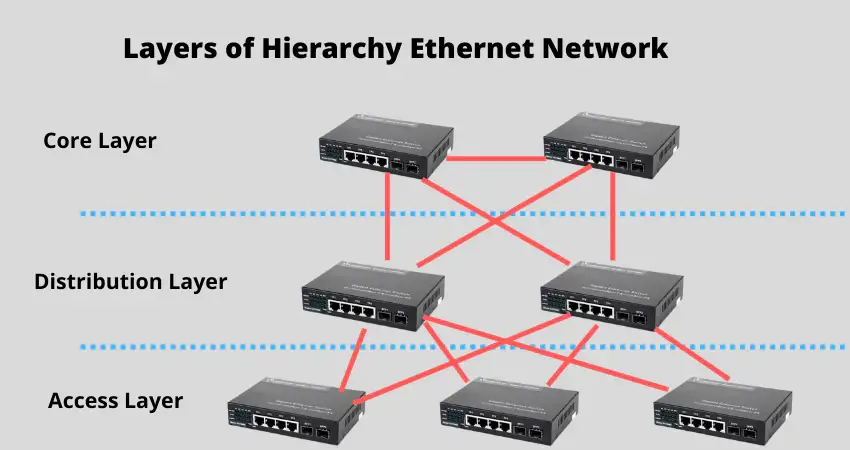Ethernet networks are becoming increasingly complex, supporting a wider range of applications and demanding more bandwidth. To handle this complexity, networks are built with a layered hierarchy, with different types of switches performing specific tasks at each layer. This blog post dives into the world of core, distribution, and access switches, explaining their roles and helping you choose the right ones for your network.
The Three Layers of a Hierarchical Network
- Core Layer: The backbone of the network, responsible for high-speed data transfer and routing between different network segments. Core switches handle massive amounts of data traffic and prioritize its efficient flow.
- Distribution Layer: Acts as an intermediary between the core and access layers. Distribution switches receive data from the core, filter and distribute it to specific groups of devices in the access layer.
- Access Layer: Provides direct connection to end-user devices like computers, printers, and phones. Access switches connect these devices to their respective subnets within the network.
Core Switches: The Powerhouse at the Center
Imagine the core switch as a multi-lane highway efficiently moving large volumes of traffic. Key features of core switches include:
- High Forwarding Rate: Capable of handling massive amounts of data packets simultaneously.
- Quality of Service (QoS): Prioritizes data traffic to ensure critical applications run smoothly.
- Redundancy: Designed for high availability with features like swappable power supplies to prevent downtime.
Distribution Switches: Directing the Flow
Distribution switches act like traffic controllers, receiving data from the core and directing it to the appropriate access layer segments. Here's what to consider for distribution switches:
- Layer 3 Compatibility: Should work seamlessly with layer 3 switches in the access layer for efficient data transfer.
- Link Aggregation: Provides redundancy in case of connection failures within the network.
- Security Features: Offers functionalities like access control lists to safeguard the network.
Access Switches: The Final Connection Point
Access switches provide the last leg of the journey, connecting devices directly to their subnets. Here are some crucial factors for access switches:
- Port Density: The number of ports available for connecting devices. More ports allow for a larger number of connected devices per switch.
- Port Speed: This should support the required data transmission speed for the connected devices. Gigabit speeds are becoming increasingly common.
- Security: Offers security protocols like access control to protect against unauthorized access.
Choosing the Right Switch for Your Needs
By understanding the core functionalities of each switch type and considering the factors mentioned above, you can select the most suitable switches for your specific network requirements.
In Conclusion
Hierarchical networks with core, distribution, and access switches offer a structured and efficient way to manage complex data traffic. By understanding their roles and key features, you can ensure a smooth-running and secure network for your business or organization.







